Turntables and vinyl are easy to use, but you should be careful as both can easily be damaged. If not careful, you might spend a ton on repair. How does a turntable work? Our experts outlined the process to make things clear and prevent you from making any costly mistakes.
The Origins and Evolution of Turntables
Thomas Edison invented the first phonograph. It is Edison’s phonograph that became the basis for today’s modern record players. The phonograph has undergone a lot of changes over the years that it doesn’t look like the original device anymore.
However, both devices produce sound waves under the same principle, through sound vibrations. Edison knew that in order to produce sound waves, there should be vibrations. He then thought of recording sound using this idea.
Edison and his team first used the telephone receiver to have a recorded sound. They thought that attaching a needle to the telephone diaphragm could be used to inscribe the movement of the sound energy in a moving paper. This is how they recorded sounds during that time.
The earliest phonograph made by Edison and his team was composed of a brass cylinder wrapped in tinfoil. This metal cylinder rotates and moves lengthwise using a hand crank. On its side is a very thin membrane called the diaphragm where the needle is attached.
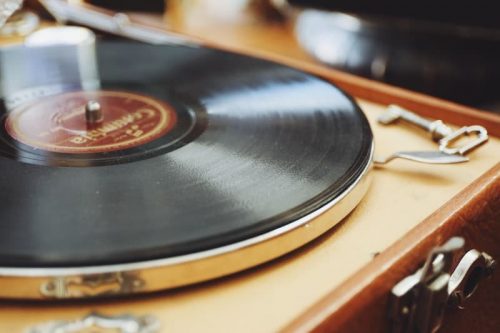
When sound waves are forced into the receiver, the membrane vibrates. This is when the needle imprints grooves into the foil as the cylinder moves through the movement of the hand crank.
A second needle and an amp are set on the other side. This helps in reproducing the original recording as the vibrations are amplified. This helps in maintaining the quality of the sound information in the record.
The first record player was used to record sound. It used grooves that were embossed into the foil. The song Mary Had A Little Lamb was the first recorded music with good sound quality.
Edison’s phonograph was an amazing feat for its time as it was able to record sound vibrations and play them back. He thought it would be useful for a variety of purposes like in dictation records, family histories, or for teachers to record lessons. He surmised this would be very important for the record industry.
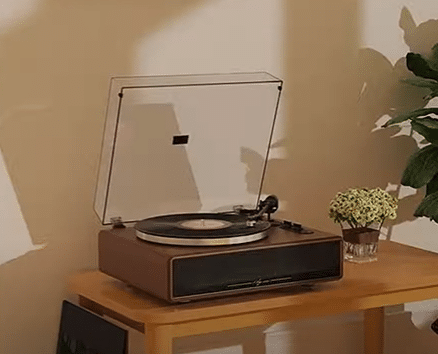
However, it did not turn out to be as easy to use for other people. The tin foils where the grooves were imprinted were of poor quality and easily damaged. Hence, the production company, as well as other people, did not sustain their interest in this invention, so Edison and his team temporarily stopped working on his phonograph.
Ten years later, Emile Berliner picked up on where they left off. Instead of using a cylinder with tin foil, he used a device that rotated a hard rubber flat disc. This rotates on a flat plate that turns also using a crank.
Berliner called his invention the gramophone [1]. Unlike the phonograph, it cannot record sounds, only play them. His company, the Gramophone company, manufactured the machine and the vinyl records that played on them.
Though the ability to record sounds was no longer included in the gramophone, it opened another possibility of mass-producing records to share and hear music repeatedly. Berliner also partnered with Victor Talking Machine company to continuously improve the gramophone.
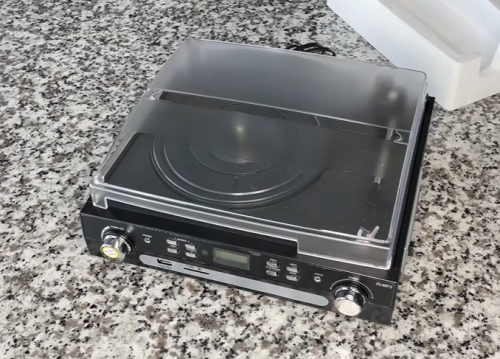
Over time, many changes in the gramophone occurred and they dominated households until the cassette tapes and compact discs took their place in terms of recordings.
Vinyl records also evolved with the record players. The process of making a record can be traced to Edison’s process. The first thing is to create a master copy of the recording where the sound is recorded. Then a lacquer is placed in the record-cutting machine.
Signals from the master copy travel to the needle. This then engraves grooves in the lacquer as it rotates. Then it is coated in metal to produce the metal master. Then it will be separated from the lacquer and it will have ridges, instead of grooves.
The metal master will be used to create the metal record, which will be used to form the stamper. The stamper will be placed in a hydraulic press and vinyl is sandwiched between them. The steam will soften the plastic as the impressions on the master recording are impressed on the vinyl. It will be stiffened by cooling it in cold water.
Important Parts and Components
Record players are also called turntables of vinyl record players. It is made of three key components: needle, tone arm, and turntable.
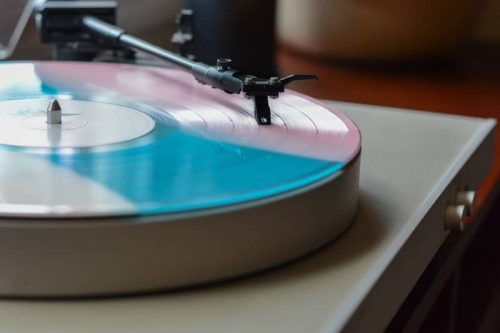
The turntable is where the record sits on. The turntable plate is usually made of metal or plastic that is covered with a rubber mat to protect the vinyl record. A metal rod on the center holds the record in place as the plate spins.
The drive system controls the plate as it spins. There are two types: belt drive or direct drive. Belt drive produces a better sound quality as the noise coming from the motor is reduced by the belt. A direct drive motor is stronger and has a better pitch control.
The needle, or stylus, comes in either elliptical or spherical shape. It is what comes into contact with the record. The tonearm holds the needle. When the needle produces the vibrations as it touches the grooves of the disc, it is the cartridge that transforms them into sounds.
The vibrations travel across the wires in the tonearm until it reaches the cartridge. Once the vibrations reach the cartridge, it hits the coils inside the magnetic field which transforms it to electric signals.
(If you are in search of a whole turntable package, you can see our list of premium turntable packages here)
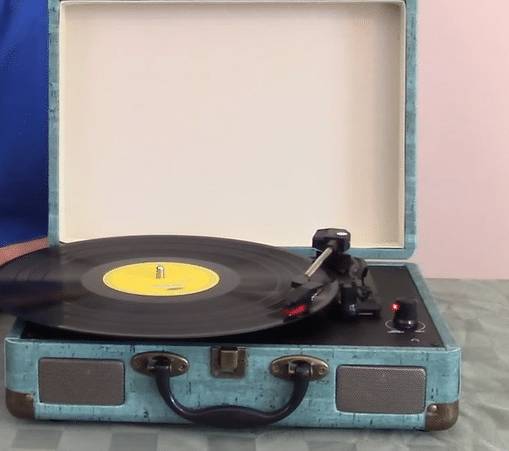
There are three main types of cartridge: moving magnet (MM), moving coil (MC), or ceramic. The ceramic cartridge is the cheapest while MM cartridge ones are moderately priced. The MC cartridge is the choice by most audiophiles but is more expensive.
The electrical signals are then sent on the preamp and active speakers. Preamp and amp are responsible for the treble, bass, and other sound frequencies. They transfer the electrical signals coming from your record player into the speakers.
The preamp boosts the low voltage signal from the record player’s cartridge to the line level. This is so it can be sent to a mixer or receiver, which then boosts the signal for the speakers
The speakers are either built with the record player or are connected by a cable. If you have a powered speaker, then there is also a built-in preamp so you can connect it directly to the speakers.
(If you are searching for impressive turntables, we have compared Crosley against Victrola turntable brands here)
How Does it Work?
How does a turntable work?
Today’s record players use a completely flat rotating platter. While older models use a rubber belt drive, this causes the record player to start slow, then gather speed. The problem lies in stopping as it will immediately stop once turned off, which then might cause some problems in the vinyl records.
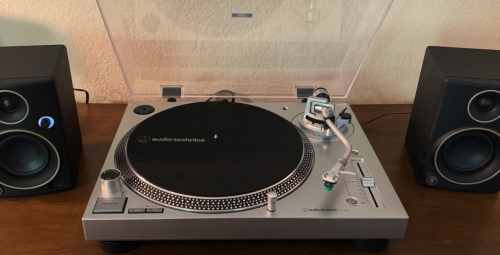
Most modern models now use a direct drive system, which means that they use electromagnets. The bearing sits on the center of the platter and allows the constant rotation of the plate. The tone arm is fixed to the base but extends all the way to the record. It can also be raised or lowered via the lever.
The needle is attached to the end of the tone arm. It is the needle that makes a direct connection with the vinyl records. When the record spins and the needle comes into contact with it, the friction recreates the sound that is engraved into the grooves.
(To update your music collection, you can buy vinyl records from these top online stores)
How to Properly Use a Turntable
Vinyl enthusiasts love a high-quality record player as it produces the best sound quality. Playing a vinyl record on a record player is not that hard. But for new users, our experts have summarized the process on how does a turntable work.
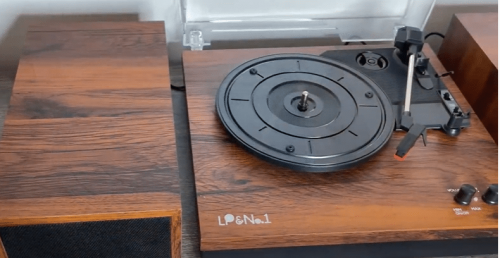
- Before placing the vinyl flat discs, you have to make sure that the platter is not spinning so as not to scratch the record. The arm should also be upwards and not in contact with the record.
- Once you are ready to play a finished vinyl record, carefully place it on the platter while holding only the disc on its edges. Place the spindle through the center of the round disc and lower it until it is resting on the platter.
- Turn it on to start the platter from spinning. Cue or lift the tonearm. Place it above the first groove to start playing music. Once you are done, lift the tone arm manually or cue it up. Afterwhich, you can stop the platter from spinning.
- To sustain the high quality of your machine, you have to make sure that the platter and the needle are free from dust. You can also use a stand to stabilize its position. Some use a wall-mounted stand so they can hang it on the wall.
FAQ
How does a turntable create sound?
A turntable creates sound by having the needle go through the grooves of the vinyl. The vibration it creates is sent into the arm until it reaches the cartridge. Once there, it hits the coils inside the magnetic field which transforms it into electrical signals. These signals are sent to the preamp and then the speakers.
Does a turntable work without a speaker?
No, a turntable will not work without a speaker. An external speaker or a built-in one is essential so the electrical signals coming from the cartridge are converted into sounds. Without a speaker, it will just remain signals, not sounds.
How do you set up a turntable?
To set up a turntable, you have to have the complete set first. A turntable consists of a turntable, preamp/amp, speakers, tone arm, needle, and cartridge. Before placing the record, make sure that the plate is not spinning. Place the record on the plate by holding it on its edges. Then lower the arm so the needle touches the outermost groove. Turn it on and enjoy the music.
Conclusion
Turntables have evolved through the years so we can enjoy quality sounds. Modern record players now let us enjoy the vinyl collection of our grandparents with the highest quality possible even if they are decades old already. Our sound engineers summarized the process of how does a turntable work so you can continue to enjoy listening to these records.
For similar products, you can also check the following list:
